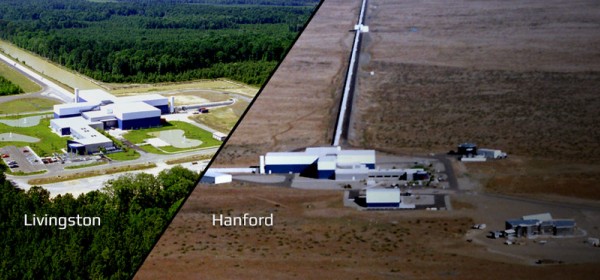 The Laser Interferometer
Gravitational-Wave Observatory (LIGO)
is a large-scale physics
experiment and observatory to
detect cosmic gravitational
waves and to develop
gravitational-wave observations
as an astronomical tool.
Two large observatories in the
USA (one in Handford, Washington
and the other in Livingstone,
Louisiana), were built with the
aim of detecting gravitational
waves by laser interferometry.
The Laser Interferometer
Gravitational-Wave Observatory (LIGO)
is a large-scale physics
experiment and observatory to
detect cosmic gravitational
waves and to develop
gravitational-wave observations
as an astronomical tool.
Two large observatories in the
USA (one in Handford, Washington
and the other in Livingstone,
Louisiana), were built with the
aim of detecting gravitational
waves by laser interferometry.
These observatories
[each] use mirrors spaced four kilometers apart which are
capable of detecting a change of
less than one ten-thousandth the
charge diameter of a proton.

The initial LIGO observatories
collected data from 2002 to 2010
but no gravitational waves were
detected.
The Advanced LIGO Project to
enhance the original LIGO
detectors began in 2008. The
improved detectors began
operation in 2015. The detection
of gravitational waves was
reported in 2016. Scientists
involved in the project and the
analysis of the data for
gravitational-wave astronomy
includes more than 1000
scientists worldwide, as well as
440,000 active Einstein@Home
users (as of December 2016).
Observations are made in "runs".
As of December 2019, LIGO has
made 3 runs, and made 50
detections of gravitational
waves. Maintenance and upgrades
of the detectors are made
between runs. The first run, O1,
which ran from September 2015 to
January 2016, made the first 3
detections, all black hole
mergers. The second run, O2,
which ran from November 2016 to
August 2017, made 8 detections,
7 black hole mergers, and the
first neutron star merger. The
third run, O3 began on 1 April
2019; it is divided (so far)
into O3a, from 1 April to 30
September 2019, and O3b, from 1
November 2019 until it was
suspended in March 2020 ...
Einstein@Home volunteers have
already discovered about fifty
new neutron stars, and hopes to
find many more. The long-term
goal is to make the first direct
detections of gravitational-wave
emission from spinning neutron
stars. Gravitational waves were
predicted by Albert Einstein a
century ago, and were directly
seen for the first time in 2015.
This observation of
gravitational waves from a pair
of merging black holes opens up
a new window on the universe,
and ushers in a new era in
astronomy. This first direct
measurement was made soon after
the advanced LIGO instruments
came online after an extensive
five-year upgrade. These
advanced detectors took data
between September 2015 and
January 2016 and can already
"see" three to six times as far
as initial LIGO, depending upon
the source type. Over the next
two years this will increase to
a factor of ten or more,
increasing the number of
potentially-visible
gravitational-wave sources by a
factor of a thousand!